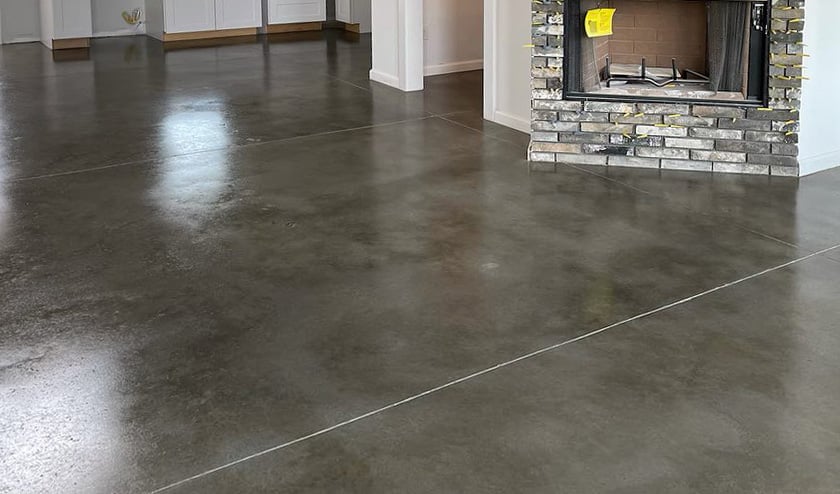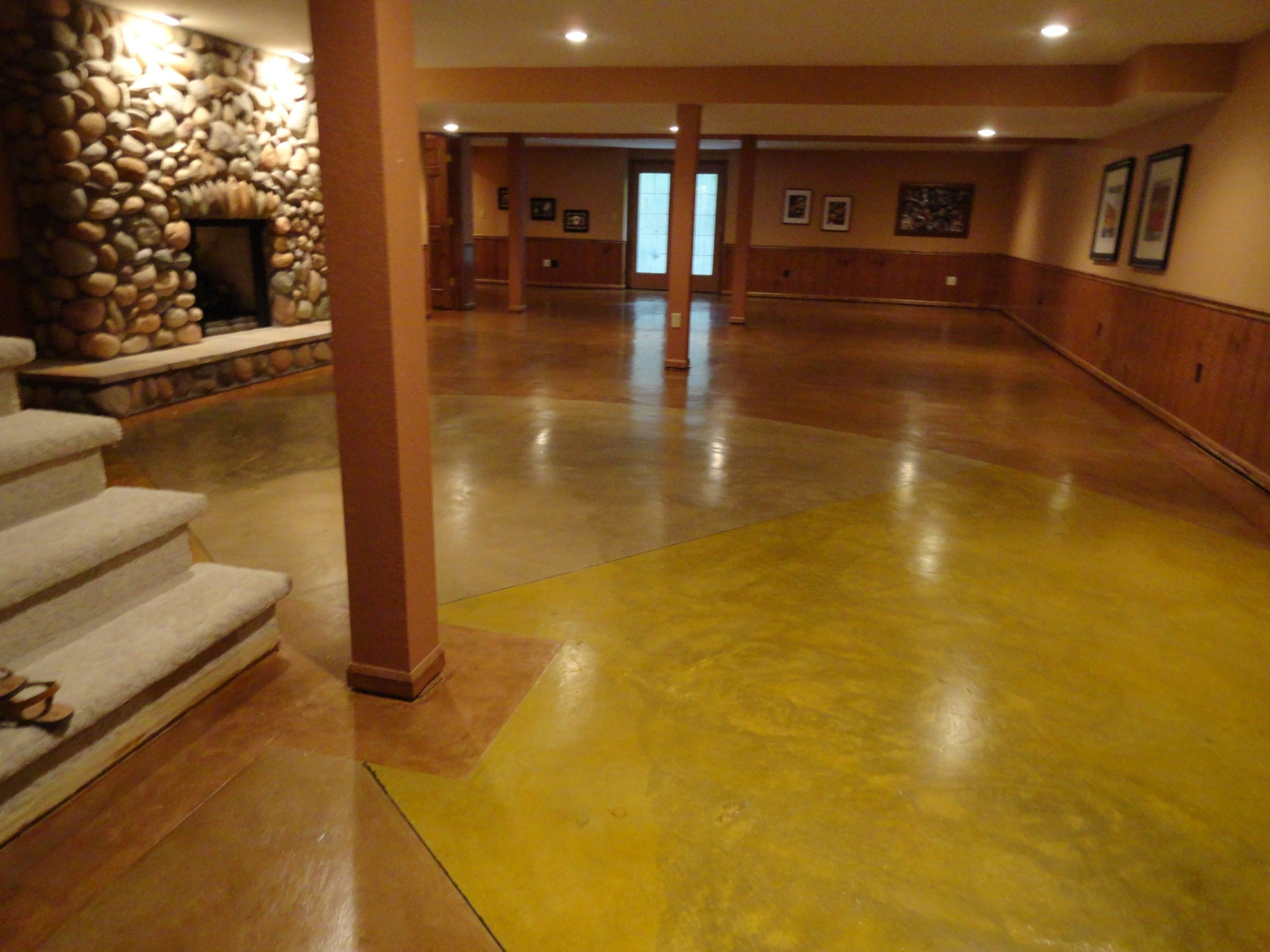Understanding the Different Kinds Of Stained Concrete for Your Next Project
Stained concrete deals various alternatives that accommodate different visual and practical needs. Each kind offers unique characteristics that influence the final look and durability of the surface. Comprehending these distinctions is crucial for anyone planning a project. From rich, chemical responses of acid-based stains to the dynamic harmony of solid color stains, the selections can greatly affect the end result. What aspects should one think about when selecting the excellent discolor for their specific needs?
Overview of Stained Concrete
Stained concrete acts as a functional floor covering option that can boost the visual appeal of various rooms. This method entails using a tinting representative to the surface of existing concrete, allowing for a wide range of style opportunities. Stained concrete is preferred in both domestic and commercial settings, offering a durable and low-maintenance option that can imitate the appearance of all-natural products like rock or floor tile.
The discoloration procedure can be carried out utilizing water-based or solvent-based items, each providing unique visual results. The last appearance is affected by aspects such as the original concrete surface, the kind of discolor used, and the application approach. Stained concrete not just improves exterior and interiors however also advertises sustainability by renewing existing concrete frameworks. Because of this, it has actually gained grip among house owners and designers looking for both capability and design in their flooring choices.
Acid-Based Stains: Attributes and Benefits

Special Color Variants
Concrete surface areas can transform significantly with the application of acid-based stains, which provide a rich palette of unique color variants. These stains penetrate the concrete, responding chemically to produce vivid planet tones that range from deep browns and reds to soft environment-friendlies and blues. The resulting shades are commonly variegated, creating a natural, marble-like appearance that boosts the concrete's personality. Each application returns distinct results due to variants in the concrete's make-up and the discoloration technique used, making every task one-of-a-kind. In addition, acid-based stains can be split or incorporated with various other techniques to create customized designs, enabling for personal expression. This versatility makes acid-based stains a popular option for both residential and commercial applications.
Chain Reaction Described
While many aspects add to the efficiency of acid-based stains, the underlying chain reaction play an important function in their one-of-a-kind features and benefits. These stains largely contain water, acid, and metal salts. When used to concrete, the acid reacts with the calcium hydroxide in the cement, producing a chemical improvement that causes permanent shade adjustments. The metal salts pass through the surface area and bond with the concrete, enabling a vast array of tones and tones. This response not just enhances aesthetic appeal but additionally gives sturdiness, making the shade immune to fading and wear. Furthermore, acid-based stains can produce a variegated surface that simulates natural rock, more improving their popularity for attractive concrete applications.
Surface Preparation Relevance
Achieving suitable results with acid-based stains rests on extensive surface area preparation. This essential action assurances that the concrete surface is tidy, without contaminants, and properly profiled for ideal tarnish absorption. Any type of existing sealants, dirt, or oils can impede the chain reaction that produces the desired color and coating, resulting in irregular or irregular results.
Prior to applying the discolor, the concrete must be mechanically cleaned or pressure cleaned, followed by a complete assessment for fractures or imperfections that might need repair service. Furthermore, verifying the surface area is adequately dried out will certainly improve discolor adherence. By prioritizing these primary actions, the durability and vibrancy of acid-based stains can be substantially enhanced, resulting in a much more visually pleasing and long lasting surface.
Water-Based Stains: Attributes and Benefits

Water-based stains pass through the concrete, offering an extra translucent coating that highlights the natural structure and variants of the surface area below. They are available in a large range of colors, permitting creative flexibility in layout. Furthermore, water-based stains are simpler to tidy up, needing just water and soap, which simplifies the application procedure.
Their quick drying out time boosts efficiency, making them a sensible option for both do it yourself lovers and experts. Overall, water-based stains provide an enticing mix of aesthetic flexibility and easy to use residential properties, making them a popular alternative for concrete improvement tasks.
Solid Shade Stains: Vivid Options for a Vibrant Look
Solid color stains use a reliable option for those looking for to create a vibrant and dynamic visual on concrete surface areas. These stains supply a consistent pigmentation that can dramatically boost the visual charm of floors, patios, and driveways. Offered in a large range of tones, solid color stains enable imaginative expression, satisfying numerous style choices.
Among the vital advantages of solid shade stains is their capability to conceal blemishes, giving a fresh and sleek aim to aging concrete - Stained Concrete Austin. In addition, their formula usually includes UV-resistant properties, making certain Full Report long life and shade retention even in harsh climate condition
Application is simple, calling for marginal preparation of the concrete surface. When applied, solid color stains can be sealed for included defense and luster, further boosting their aesthetic top quality. With their lively choices, solid shade stains are an exceptional choice for those aiming for an impactful and natural layout.
Semi-Transparent Stains: Attaining Deepness and Measurement
Semi-transparent stains offer a special method to boosting concrete surfaces by giving depth and measurement with different shade choices. Comprehending the application methods is vital for accomplishing the desired effect, while appropriate upkeep methods ensure longevity. This section will discover these crucial aspects to make best use of the advantages of semi-transparent discoloration.
Color Options Available
A variety of color options exists for semi-transparent stains, allowing homeowners and developers to improve the natural charm of concrete surfaces. These stains can be found in an array of tones, from earthy tones like browns and terracottas to vibrant shades such as blues and environment-friendlies. find here The semi-transparent nature of these stains enables the underlying concrete to reveal with, producing an one-of-a-kind depth and dimension that can match numerous style aesthetic appeals. In addition, incorporating different shades can produce personalized tones, allowing a customized look for each task. This versatility makes semi-transparent stains a prominent option for both exterior and interior applications, as they can harmonize with surrounding elements while adding visual passion to plain concrete.
Application Techniques Discussed
To achieve the wanted depth and dimension with semi-transparent stains, appropriate application methods are necessary. Initially, surface area preparation is crucial; the concrete needs to be clean and without any pollutants. This often involves power washing and fixing any type of fractures. Next off, picking the best applicator, such as a sprayer, roller, or brush, can influence the final look. Sprayers enable an extra even application, while rollers can help attain texture. It is necessary to use the stain in thin, also coats, enabling each layer to completely dry before adding one more. Manipulating the application method, such as varying stress or using different tools, can produce one-of-a-kind effects. Securing the stained surface boosts the vibrancy of the colors while offering defense.
Maintenance Ideal Practices
Normal maintenance is vital for maintaining the beauty and honesty of surface areas treated with semi-transparent stains. To keep these surface areas, regular cleansing is crucial. Utilizing a pH-neutral cleaner and a soft-bristle broom will certainly help get rid of dust and debris without damaging the discolor. It is suggested to stay clear of rough chemicals, as they can degrade the stain's appearance. In addition, periodic resealing each to three years can protect against wear and fading. This process entails cleansing the surface area extensively and applying a suitable sealer made for stained concrete. Homeowners need to likewise check for any type of indications of staining or damage and address these concerns promptly to guarantee durable vibrancy and longevity. Adhering to these finest techniques will enhance the total life expectancy of semi-transparent stained surface areas.
Results and Methods: Personalizing Your Stained Concrete
Tailoring stained concrete includes a range of strategies that boost both appearances and performance. Amongst these techniques, layering different discolor colors can produce depth and intricacy, enabling unique visual effects. Techniques such as acid staining supply a variegated appearance, while water-based stains use a more uniform look.
Additionally, integrating attractive patterns, such as stenciling or inscription, can further personalize the surface, adding intricate styles that cater to individual preferences. Texturing the concrete, whether via marking or mop coatings, presents tactile aspects that not just improve grasp but likewise boost visual passion.
Applying sealers can enhance the color vibrancy and supply protection versus wear. Personalization methods expand past plain shade; they can transform a basic concrete slab right into a magnificent prime focus, making it suitable for both property and business areas. Through careful selection of impacts and techniques, stained concrete can accomplish an absolutely customized look.
Maintenance and Durability of Stained Surfaces
Although stained concrete surface areas are understood for their sturdiness and visual allure, keeping their stability is important for guaranteeing durability. Normal cleaning is important; sweeping and mopping with a pH-neutral cleaner aids avoid dust build-up and staining. Furthermore, using a sealant every couple of years can safeguard the surface from dampness, chemicals, and UV damages, thus improving its lifespan.
It is likewise essential to deal with any type of splits or chips immediately. Small repair services can alleviate further deterioration, maintaining the aesthetic and structural top quality of the surface area. For exterior stained concrete, seasonal upkeep, check my reference such as getting rid of snow and ice, is essential to avoid surface damages from freeze-thaw cycles.
Often Asked Inquiries
Can I Discolor Existing Concrete Surfaces or Only Brand-new Ones?
The concern of whether existing concrete surfaces can be stained emerges frequently. It is without a doubt feasible to discolor both brand-new and old concrete, offered the surface area is appropriately ready and free of impurities for perfect attachment.
For how long Does the Discoloration Refine Typically Take?
The discoloration process commonly takes one to 3 days, depending upon variables such as surface prep work, type of discolor, and weather. Stained Concrete Floors Austin Tx. Treating time might prolong beyond initial application, influencing the total duration substantially
Is Stained Concrete Safe for Outdoor Usage?
Stained concrete is usually secure for outdoor use, provided it is effectively sealed. This securing safeguards versus dampness and UV damage, making certain toughness and security, while also boosting the aesthetic appeal of exterior areas.
Can I Use Multiple Discoloration Layers for Different Results?
Applying numerous tarnish layers can achieve diverse effects on stained concrete. However, it is vital to ensure compatibility in between stains and enable correct drying out time between applications to stay clear of unexpected reactions or discoloration.
Are There Any Type Of Color Limitations for Stained Concrete?
Shade constraints for stained concrete mainly depend on the kind of discolor utilized, with water-based stains supplying a more comprehensive scheme contrasted to acid-based stains. Stained Concrete Floors Austin Texas. Nevertheless, accomplishing dynamic shades might require careful option and application strategies